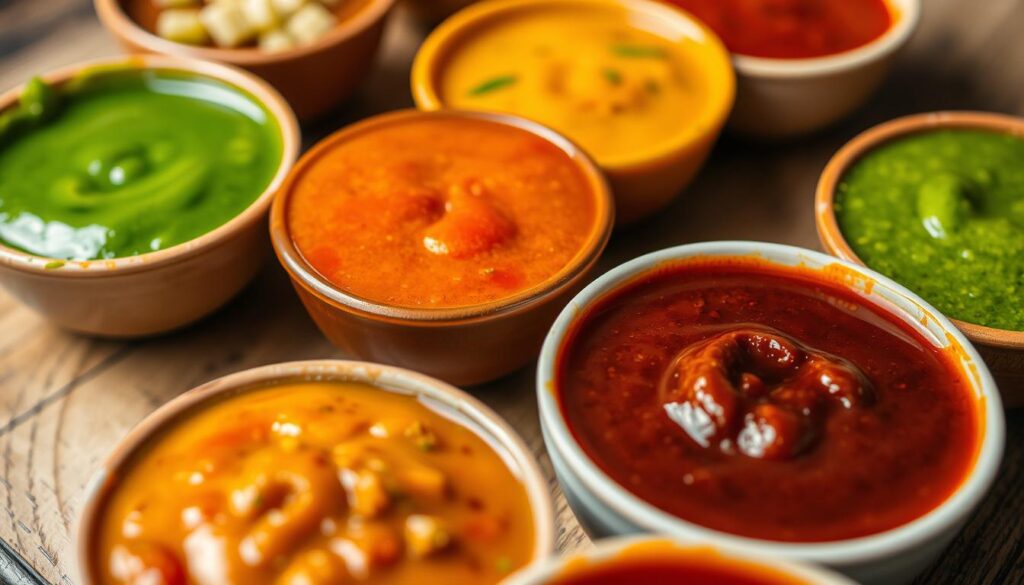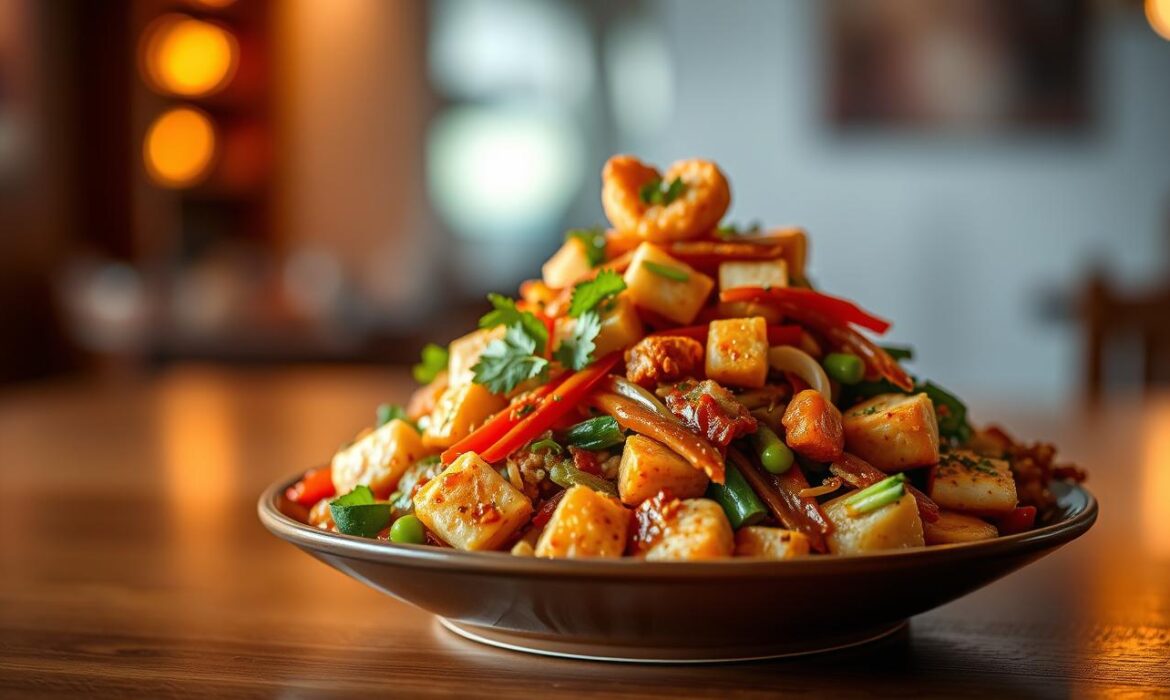Singapore’s street food scene is legendary, and rojak stands out as a flavorful favorite. This iconic dish blends sweet, spicy, and tangy flavors in a way that captures the essence of local cuisine. Whether you’re a visitor or a longtime resident, tasting this dish is a must.
From bustling hawker centers to hidden neighborhood stalls, we’ve scoured the city to bring you the most delicious options. Our curated list includes spots like Ayer Rajah Food Centre and Dunman Food Centre, where authentic recipes and secret sauces shine.
Get ready to explore unique flavor profiles, insider tips, and crowd-beating strategies. Let’s dive into Singapore’s vibrant food culture one bite at a time!
Key Takeaways
- Singapore’s rojak offers a mix of sweet, spicy, and tangy flavors.
- Iconic locations like Ayer Rajah Food Centre serve top-tier versions.
- Authentic recipes and secret sauces make each stall unique.
- This guide covers hidden gems and popular spots alike.
- Upcoming sections will share pairing tips and ordering tricks.
What Makes Rojak Singapore’s Must-Try Dish?
Few dishes capture Singapore’s culinary diversity like the beloved rojak. This vibrant dish blends Chinese, Malay, and Indian influences into a single plate—crunchy, sweet, and spicy all at once. It’s no wonder locals and visitors alike queue up for a taste.
The Unique Blend of Flavors
Rojak’s magic lies in its balance. Tamarind and lime juice bring tangy brightness, while chili adds a fiery kick. The sauce—a mix of prawn paste and toasted peanuts—ties everything together with umami depth.
Key Ingredients in Authentic Rojak
Freshness is non-negotiable. Hawkers combine crisp vegetables like jicama and cucumber with tropical fruits such as pineapple. Crispy youtiao (fried dough) soaks up the sauce, adding texture. Every stall has its twist, but these staples are universal:
- Crunchy base: Jicama, cucumber, and bean sprouts
- Sweet contrast: Pineapple and green apple
- Signature sauce: Hae ko (prawn paste), peanuts, and lime
Regional variations tweak ratios—some add more spice, others extra sweetness—but the soul of the dish remains.
Top Rojak Stalls in Singapore You Can’t Miss
Three family-run stalls have perfected their recipes over decades. Each brings distinct textures and secret sauces that keep regulars coming back. Discover why these spots dominate conversations among hawker enthusiasts.
![]()
Hong Ser Rojak: A Legend at Ayer Rajah Food Centre
Lau Hong Ser has dished out crispy delights since 1983 at Block 503 West Coast Drive. Their version stands out with hand-cut jicama and a prawn paste sauce that’s thick but never overpowering.
Insiders arrive before 11 AM to skip lines. Ask for extra fried dough—it stays crunchy even after soaking up the signature glaze.
684 Black White Rojak: A Dunman Food Centre Gem
This rojak stall nails the sauce-to-ingredient ratio. Every bite of pineapple or cucumber gets evenly coated in their peanut-heavy blend. The name hints at their minimalist approach: no frills, just bold flavors.
Weekend afternoons get busy. Their chopped peanuts add a satisfying crunch that contrasts with soft tofu puffs.
Soon Heng Rojak: Balestier Road’s Hidden Star
Near Hoover Park, this spot fries tau pok (tofu puffs) to order for maximum crispness. Their sauce leans sweeter, with tamarind cutting through the richness.
Pro tip: Pair it with their house-made lime juice. The tangy drink balances the dish’s savory depth perfectly.
Best Food Centres for Rojak Cravings
Craving a flavorful mix of textures and tastes? Head to these food centres. From hidden gems to well-known hubs, they serve up unforgettable street food experiences.

Ayer Rajah Food Centre: A Hawker Haven
At Ayer Rajah Food Centre, the aroma of sizzling satay blends with the tangy scent of prawn paste. Beyond Hong Ser, stalls like Lim’s Fried Oyster offer crispy alternatives.
Parking is ample, but the nearby Clementi MRT makes it easy to reach. Arrive early—lines form fast for the freshest cuts of jicama and pineapple.
Dunman Food Centre: Where Locals Queue
Dunman Food Centre sits in Tiong Bahru, a hotspot for food lovers. Its 684 Black White Rojak stall draws crowds with peanut-heavy sauces.
Weekday lunches are quieter. Pair your plate with nearby soy milk or curry puffs for a full meal.
| Feature | Ayer Rajah | Dunman |
|---|---|---|
| MRT Access | Clementi (5-min walk) | Tiong Bahru (3-min walk) |
| Parking | Spacious lot | Limited spots |
| Must-Try Pairing | Satay | Soy Milk |
Both market food centres uphold strict cleanliness, with regular sanitization. Napkins and hand gel are plentiful—ideal for messy, sauce-heavy meals.
Exploring Rojak Varieties: From Indian to Chinese
From crispy fritters to tropical fruits, rojak comes in many delicious forms. Whether you prefer bold spices or sweet-savory blends, Singapore’s stalls cater to every palate. Let’s uncover the differences between two beloved styles.
![]()
Indian Rojak: Crispy Fritters and Peanut Sauce
Indian rojak swaps fruits for crunchy bites like fried bittergourd, tempeh, and hard-boiled eggs. Its orange-hued sauce, made with ground peanuts and chili, packs a fiery punch. Unlike its Chinese counterpart, it’s often served with fluffy tofu puffs to balance the heat.
Chinese Rojak: Sweet Prawn Paste Delight
This version stars a thick black prawn sauce blended with toasted sesame seeds. Juicy pineapple, jicama, and cucumber add freshness, while youtiao (fried dough) soaks up the glaze. The result? A sticky-sweet harmony that’s hard to resist.
| Feature | Indian Rojak | Chinese Rojak |
|---|---|---|
| Sauce Base | Peanut-chili mix | Black prawn paste |
| Key Ingredients | Bittergourd, tempeh | Pineapple, sesame seeds |
| Texture | Extra crispy | Chewy with crunch |
For a twist, try fusion stalls like Rojak Lab, which layers both sauces. Vegetarians can request egg-free white rojak—many vendors happily customize. No matter your pick, each variety offers a fresh take on this iconic dish.
Secret Sauces and Signature Twists
What separates ordinary rojak from extraordinary? The secret’s in the sauce. From fermented prawn paste to zesty lime juice, each stall guards its recipe like treasure. Here’s how these ingredients elevate the dish into a symphony of flavours.

The Magic of Homemade Prawn Paste
Hong Ser’s prawn paste takes three days to ferment—a process that deepens its umami richness. Unlike store-bought versions, their blend balances saltiness with a hint of sweetness, clinging perfectly to crisp jicama and pineapple.
Other stalls tweak viscosity. Some sauces pour like syrup, while others thicken into a glaze. The key? Toasted peanut texture and slow simmering.
Lime Juice: The Zesty Game-Changer
A squeeze of lime juice does more than add tang. It prevents fruits from browning and brightens the sauce’s richness. At Soon Heng, they use calamansi for an extra citrusy punch.
- DIY tip: Mix tamarind pulp, palm sugar, and a dash of fish sauce for a quick prawn paste alternative.
- Health twist: Swap sugar with honey or reduce sauce portions for lighter flavours.
| Stall | Sauce Texture | Secret Ingredient |
|---|---|---|
| Hong Ser | Thick, sticky | Fermented shrimp head paste |
| 684 Black White | Peanut-heavy, grainy | Crushed toasted peanuts |
| Soon Heng | Light, drizzle-friendly | Calamansi lime zest |
When to Visit These Rojak Stalls
Timing is everything when hunting for the perfect plate of rojak. Beat the crowds with these insider tips on off-peak hours and closures. Plan wisely to savor every bite without the wait.
Beat the Crowds: Off-Peak Hours
Hong Ser’s stall at Ayer Rajah is busiest from 11 AM–1 PM. Arrive by 10:30 AM or after 2 PM for shorter lines. *Pro tip*: They close every other Monday—check their Facebook for updates.
At Dunman Food Centre, 684 Black White sees a lull between 2–4 PM on weekdays. Weekends? Expect a wait of 20+ minutes post-noon. Their peanut-heavy sauce is worth it, though.
Soon Heng in Balestier is a hidden spot with manageable queues before 11:30 AM. Avoid Friday evenings—nearby office workers swarm the area.
Weekday vs. Weekend Availability
Weekday afternoons (Tuesday–Thursday) are ideal. Saturday lunches triple weekend crowds, especially at Dunman. Tuesday evenings? Almost no lines.
- Real-time tracking: Follow stalls on Instagram for live updates.
- Group orders: Send one person ahead to secure your plate faster.
- Closures: Lau Hong Ser’s biweekly Monday shutdown catches many off guard.
Pair these strategies with off-peak visits, and you’ll spend less time in line and more time enjoying crispy, saucy goodness.
Pairing Rojak with Other Local Delights
A plate of rojak tastes even better with the right companions. Hawkers often recommend combos that balance textures and flavors. Try these winning pairings to elevate your meal.
Satay and Rojak: A Match Made in Heaven
Satay’s smoky depth complements rojak’s tangy sauce. Chicken satay works well with Chinese-style rojak, while mutton pairs better with spicier Indian versions. Nearby stalls at Ayer Rajah serve skewers with peanut dip—order a half-dozen to share.
For a lighter twist, add sotong (squid) to your rojak. Its chewiness contrasts with crispy veggies. A typical plate with satay runs ~450 calories—ideal for a hearty snack.
Iced Lime Juice: The Perfect Refreshment
Nothing cuts through the prawn paste’s richness like lime juice. The drink stall beside 684 Black White uses freshly squeezed calamansi for extra zing. Its citrusy punch cleanses the palate between bites.
- Pro tip: Ask for less sugar to highlight the lime’s natural tartness.
- Healthier sip: Try barley water for a neutral, low-calorie alternative.
| Pairing | Best With | Calories (approx.) |
|---|---|---|
| Chicken Satay | Chinese Rojak | 300 (3 skewers) |
| Iced Lime Juice | Any Style | 80 (regular) |
| Soy Milk | Indian Rojak | 120 (cold) |
Local vendors swear by these combos. Next time, skip the soda—let the food shine with these curated matches.
Tips for Enjoying the Best Rojak in Singapore
Avoid rookie mistakes and savor rojak like a local with these insider secrets. From crispy add-ons to heat adjustments, small tweaks make a big difference.
Ask for Extra Tau Pok (Fried Tofu)
Crunchy tau pok soaks up sauce beautifully. At stalls like Hong Ser, say *”Ka ki nang”* (Hokkien for “make yourself”) to customize your plate. Some vendors charge for extra toppings, while others include them free.
- Free toppings: Soon Heng adds crispy tofu puffs at no cost.
- Paid upgrades: 684 Black White offers double tau pok for $1 more.
- Reheating tip: For takeaway, air-fry leftovers at 350°F for 2 minutes to restore crispness.
Tailor Your Spice Level
Not all chili packs the same punch. Local spice levels range from “mild” (500 Scoville) to “suicide” (10,000+).
| Level | Heat Equivalent | Best For |
|---|---|---|
| Mild | Bell pepper | First-timers |
| Medium | Jalapeño | Balanced heat |
| Suicide | Thai bird’s eye | Daredevils |
Tourists often overdress their salad—start with sauce on the side. Pro tip: Ask for chili separately to test your tolerance first.
Conclusion: Your Ultimate Rojak Adventure Awaits
Ready to dive into Singapore’s vibrant food culture? From Hong Ser’s thick prawn paste to 684’s peanut-heavy crunch, your taste buds are in for a treat. Each stall offers a unique twist on this beloved dish.
Pack smart for your journey: wet wipes, cash (many stalls don’t accept cards), and a portable fan for queue-heavy spots. Don’t miss the annual Rojak Fest in November—it’s a flavor explosion.
Found a hidden gem? Tag featured stalls like @SoonHengRojak on Instagram. For hard-to-find locations like Balestier Road, use GPS coordinates (1.3276° N, 103.8507° E).
Now, grab your chopsticks and explore. Every bite tells a story of tradition, innovation, and sheer deliciousness. Happy eating!



